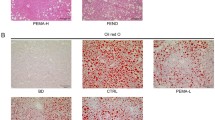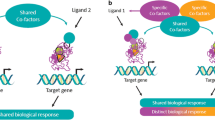Abstract
The long-term clinical effects of ACE-inhibitors have similarities with those of both fibrates and glitazones, activators of peroxisome proliferator activator receptor (PPAR) alpha and gamma, respectively. The antioxidant enzyme catalase, a heme protein that degrades hydrogen peroxide, is found at high concentrations in peroxisomes. Catalase activity is one of the recognized surrogate markers indicative of PPAR activation in the rat liver. The purpose of the study was to establish the effect of moexipril on catalase activity and to compare it with the effect of both saline controls and that of the known PPAR agonist clofibrate (positive control). Three groups of seven rats were used. All substances were applied i.p. daily for 5 days, followed by a 2-day break. The cycle was repeated eight times. After the final cycle (day 56) the animals were sacrificed and liver tissue collected. The number of catalase positive cells in both moexipril group (95% CI 57–61) and clofibrate group (95% CI 72–80) is higher than in controls (95% CI 3–16) (p ≤ 0.01). The number of catalase positive cells in the clofibrate group is higher than in the moexipril group (p ≤ 0.01). High-dose subchronic exposure to the ACE-inhibitor moexipril induces catalase activity in the rat liver to an extent comparable to fibrates. We suggest that some of the long-term advantages of ACE inhibitor use – beyond mere BP lowering – might be due to a PPAR mediated effect. (Mol Cell Biochem xxx: 159–163, 2005)
Similar content being viewed by others
References
Gerstein HC: Reduction of cardiovascular events and microvascular complications in diabetes with ACE inhibitor treatment: HOPE and MICRO-HOPE. Diabetes Metab Res Rev 18: 82–85, 2002
Zanella MT, Kohlmann O Jr, Ribeiro AB: Treatment of obesity hypertension and diabetes syndrome. Hypertension 38: 705–708, 2001
McFarlane SI, Kumar A, Sowers JR: Mechanisms by which angiotensin-converting enzyme inhibitors prevent diabetes and cardiovascular disease. Am J Cardiol 91: 30–37, 2003
Mehendale HM: PPAR-alpha: A key to the mechanism of hepatoprotection by clofibrate. Toxicol Sci 57: 187–190, 2000
Sakamoto J, Kimura H, Moriyama S, Odaka H, Momose Y, Sugiyama Y, Sawada H: Activation of human peroxisome proliferator-activated receptor (PPAR) subtypes by pioglitazone. Biochem Biophys Res Commun 278: 704–711, 2000
Yki-Jarvinen H: Thiazolidinediones. N Engl J Med 351: 1106–1118, 2004
Wilcke M, Alexson SE: Differential induction of peroxisomal populations in subcellular fractions of rat liver. Biochim Biophys Acta 1544: 358–369, 2001
Girnun GD, Domann FE, Moore SA, Robbins ME: Identification of a functional peroxisome proliferator-activated receptor response element in the rat catalase promoter. Mol Endocrinol 16: 2793–2801, 2002
Akbiyik F, Cinar K, Demirpence E, Ozsullu T, Tunca R, Haziroglu R, Yurdaydin C, Uzunalimoglu O, Bozkaya H: Ligand-induced expression of peroxisome proliferator-activated receptor alpha and activation of fatty acid oxidation enzymes in fatty liver. Eur J Clin Invest 34: 429–435, 2004
Akbiyik F, Ray D, Bozkaya H, Demirpence E: Ligand- and species-dependent activation of PPARalpha. Cell Physiol Biochem 14: 269–276, 2004
Zamboni L, de Martino C: Buffered picric acid-formaldehyde: A new rapid fixation for electron microscopy. J Cell Biol 35: 148A, 1967
Perneger TV: What's wrong with Bonferroni adjustments? BMJ 316: 1236–1238, 1998
Smith CG, Vane JR: The Discovery of Captopril. FASEB J 17: 788–789, 2003
Cushman DW, Ondetti MA: History of the design of captopril and related inhibitors of angiotensin converting enzyme. Hypertension 17: 589–592, 1991
Chrysant SG, Chrysant GS: Pharmacological and clinical profile of moexipril: A concise review. J Clin Pharmacol 44: 827–836, 2004
Cawello W, Boekens H, Waitzinger J, Miller U: Moexipril shows a long duration of action related to an extended pharmacokinetic half life and prolonged ACE inhibition. Internat J Clin Pharmacol Ther 40: 9–17, 2002
Brogden RN, Wiseman LR: Moexipril. A review of its use in the management of essential hypertension. Drugs 55: 845–860, 1998
Thorp JM, Waring WS: Modification of metabolism and distribution of lipids by ethyl chlorophenoxyisobutyrate. Nature 194: 948–949, 1962
Crouthamel WG, Cenedella RJ: Clofibrate pharmacokinetics: Effect of elevation of plasma-free fatty acids. Pharmacology 13: 465–473, 1975
Sridhar GR: Peroxisome proliferator-activated receptors as molecular targets for drug therapy. J Assoc Physicians India 51: 49–52, 2003
Roglans N, Bellido A, Rodriguez C, Cabrero A, Novell F, Ros E, Zambon D, Laguna JC: Fibrate treatment does not modify the expression of acyl coenzyme A oxidase in human liver. Clin Pharmacol Ther 72: 692–701, 2002
Ammerschlaeger M, Beigel J, Klein KU, Mueller SO: Characterization of the species-specificity of peroxisome proliferators in rat and human hepatocytes. Toxicol Sci 78: 229–240, 2004
Tordjman K, Standley KN, Bernal-Mizrachi C, Leone TC, Coleman T, Kelly DP, Semenkovich CF: PPARalpha suppresses insulin secretion and induces UCP2 in insulinoma cells. Lipid Res 43: 936–943, 2002
Author information
Authors and Affiliations
Corresponding author
Rights and permissions
About this article
Cite this article
Adeghate, E., Hasan, M.Y., Ponery, A.S. et al. Subchronic exposure to high-dose ACE-inhibitor moexipril induces catalase activity in rat liver. Mol Cell Biochem 280, 159–163 (2005). https://doi.org/10.1007/s11010-005-8843-6
Received:
Accepted:
Issue Date:
DOI: https://doi.org/10.1007/s11010-005-8843-6




